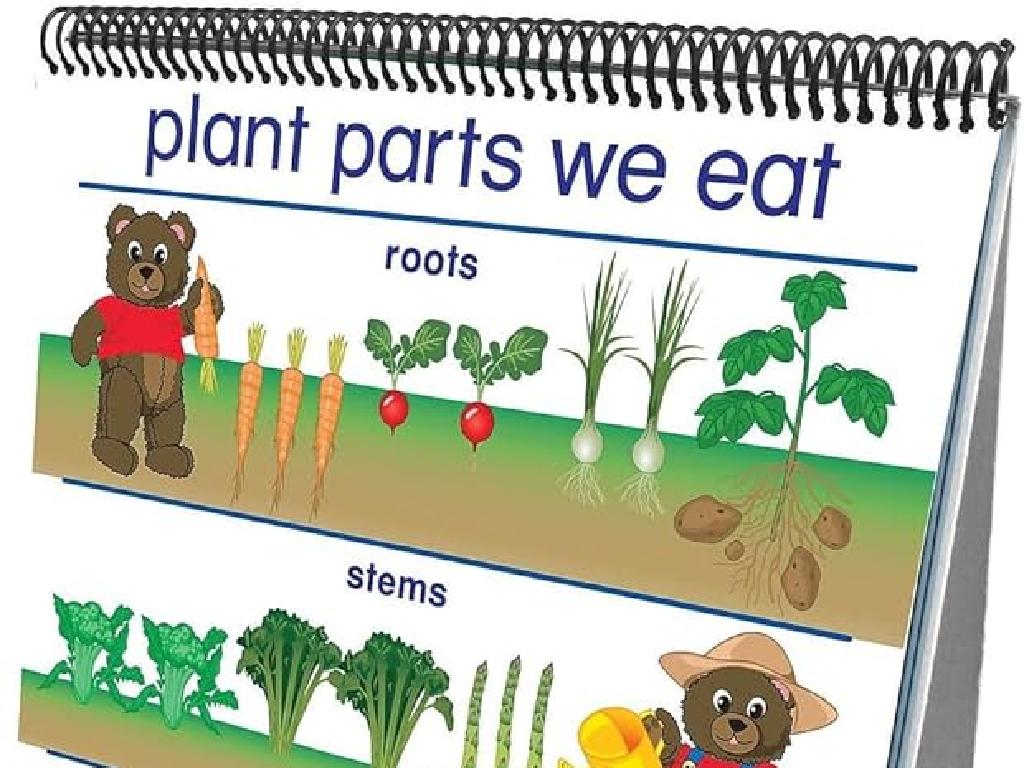Pollinator: Indian Flying Fox
Subject: Science
Grade: First grade
Topic: Animals
Please LOG IN to download the presentation. Access is available to registered users only.
View More Content
Welcome to the World of Pollinators!
– Meet the Indian flying fox
– A big bat that helps plants grow
– What is a pollinator?
– Animals that move pollen between flowers
– Importance of pollinators
– They help plants make fruits and seeds
– The flying fox’s role in nature
– Indian flying foxes spread seeds by eating fruit
|
Introduce the Indian flying fox as a fascinating pollinator to spark interest among first graders. Explain the concept of pollinators as animals that help plants by moving pollen, which is necessary for plants to produce fruits and seeds. Emphasize the importance of pollinators in nature by discussing how they support the growth of plants, which in turn provide food for other animals and humans. Highlight the specific role of the Indian flying fox in this process, such as how they contribute to seed dispersal by eating fruits and carrying seeds to new locations. Use simple language and relatable examples to make the content accessible for first-grade students.
Meet the Indian Flying Fox
– A special type of bat
– One of the largest bats
– It has a wingspan as big as a small child!
– Enjoys eating fruits
– Like mangoes, bananas, and figs
– Helps plants grow
– Spreads seeds after eating, which helps new plants to sprout
|
The Indian flying fox is a fascinating creature that sparks interest among first graders due to its unique characteristics. It’s not just any bat; it’s one of the biggest in the world, which can be compared to the size of the children to make it more relatable. Their diet consists mainly of fruits, making them important pollinators in their ecosystems. As they eat, they spread seeds, contributing to the growth of new plants. This slide aims to introduce the Indian flying fox and highlight its role in nature, encouraging students to appreciate biodiversity and the interconnectedness of living organisms.
What Do Indian Flying Foxes Look Like?
– Long wings and furry body
– Sharp eyes and a helpful nose
– They use their sharp eyes and nose to locate fruit, even in the dark!
– Wings as wide as an adult’s arms
– Imagine spreading your arms; their wings can be that big!
– Designed for finding fruit
– Their body is perfectly adapted to their diet of fruits.
|
This slide introduces the physical characteristics of the Indian flying fox to first graders. Emphasize the unique features that help these animals survive and thrive in their environment. Explain how their long wings help them glide through the air and their furry bodies keep them warm. Highlight their sharp eyesight and strong sense of smell, which are crucial for finding their favorite food, fruit. Use a comparison to an adult’s arm span to give students a relatable understanding of the flying fox’s wing size. Encourage students to think about how these features help the flying fox live and find food. You can bring a tape measure to class to show the actual wingspan or use a visual aid to compare the size.
How Indian Flying Foxes Help Flowers Grow
– What is pollination?
– Moving pollen from one flower to another
– Pollination makes new plants
– Seeds are made when flowers are pollinated
– Flying foxes as pollinators
– They get pollen on fur while eating fruit
– Flying foxes spread pollen
|
This slide introduces the concept of pollination and the role of the Indian flying fox in this process. Explain to students that pollination is like a puzzle that helps flowers make seeds, which grow into new plants. When Indian flying foxes eat fruit, they accidentally get pollen on their bodies, and when they visit the next flower, they transfer the pollen, helping the plants to reproduce. Emphasize the importance of these animals in nature and how they help our environment. You can bring a fruit to class and show how touching it can transfer its juices to another object, simulating how pollen is transferred.
The Life of an Indian Flying Fox
– Indian flying foxes’ home
– They live in trees known as ‘roosts’.
– Sleep by day, fly by night
– They rest during daylight and search for food in the dark.
– Eating habits at night
– They look for fruits and flowers to eat at night.
– Living in big groups
– They stay with many others in ‘colonies’.
|
This slide introduces the Indian flying fox, a type of fruit bat, to first graders. Emphasize that these animals have specific behaviors and habitats. They sleep in trees during the day, which are called ‘roosts’, similar to how children have their own bedrooms. At night, when it’s dark, they go out to find their food, which includes fruits and flowers, much like going to a grocery store. They are very social and like to be with friends and family, living in large groups called colonies. Encourage the children to think about how the flying foxes’ lifestyle is both similar to and different from their own, fostering a connection with the animal.
Protecting Our Flying Friends
– Indian flying foxes are important
– They help plants grow by spreading seeds
– Protect their homes by caring for trees
– Trees are where they live and find food
– Do not disturb resting flying foxes
– They need sleep during the day to stay healthy
– Why protecting them helps us too
– Healthy flying foxes mean more plants and cleaner air
|
This slide aims to educate first graders on the importance of the Indian flying fox, a type of large fruit bat, and how we can help protect them. Emphasize that these animals play a crucial role in our ecosystem by spreading seeds that grow into new plants. Encourage children to respect nature by not harming the trees that are the homes of these creatures and by not disturbing them when they see them resting during the day. Explain that by protecting the Indian flying foxes, we also protect our environment, leading to more plants, which are important for clean air and a healthy planet. Activities can include making posters about protecting flying foxes or planting a tree to create more homes for them.
Class Activity: Craft Your Own Indian Flying Fox
– Gather paper and colors
– Follow steps to cut and color
– Create your paper flying fox
– Display your flying fox in class
Our crafts will remind us of how flying foxes help nature!
|
This activity is designed to engage students with the concept of pollinators through a fun and creative craft. Provide each student with construction paper, safety scissors, crayons or markers, and a template for the Indian flying fox. Guide them through the steps of cutting out the shape and coloring it to resemble a flying fox. Once completed, help them hang their crafts around the classroom. This will serve as a visual reminder of the pollination process and the role of the Indian flying fox in nature. Possible variations of the activity could include using different materials to create a 3D model, adding string to make the flying fox ‘fly’, or even a group activity to create a tree on a bulletin board where all the flying foxes can ‘hang’. The goal is to reinforce the importance of pollinators in our ecosystem in a memorable way.





